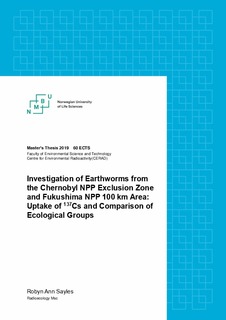| dc.description.abstract | Earthworm species inhabit the soil profile, burrowing and feeding in the soil. In the case of a nuclear accident, such as the Chernobyl Nuclear Power Plant (ChNPP) accident in 1986 and the Fukushima Daiichi Nuclear Power Plant (FDNPP) accident in 2011, the soil is contaminated with the resulting deposition.
Earthworm species can be categorized into three different ecological groups, Epigeic, Endogeic and Anecic, based of burrowing a feeding behavior at different depths of the soil profile. In this study Epigeic and Endogeic earthworms were investigated to determine if these differences have any effect of the uptake of Cs-137. Samples were collected by the COMET, 2017, project as part of the project: “COMET - Initial Research Activity on transgenerational effects and role of epigenetics: Results and Impact”, from both the ChNPP Exclusion Zone and the FDNPP 100 km Area. In addition to this samples were also tested for evidence of uptake of Cs-137 from the gut contents into the tissue.
A Mann-Whitney non-parametric test was applied to the ecological groups from the ChNPP Exclusion Zone, which resulted is the difference between the Epigeic and Endogeic earthworm groups not being statistic significant, therefore, it cannot be concluded that there is a difference in the uptake of Cs-137 between the two ecological groups. However, very few sample sites had examples of samples from both ecological groups, therefore It was not possible to eliminate the factor of some sites having a higher activity than other sites, this was a problem for the Endogeic earthworm group which had one sample much higher than the rest, resulting in the mean being skewed.
The uptake in the skin never exceeded 10% of the gut contents, however there was evidence that there was a small amount of uptake into the tissues from both the samples at the FDNPP 100 km Area and the ChNPP Exclusion Zone. Many of the skin samples of earthworms collected from the ChNPP Exclusion Zone did not exceed the Ld and therefore were collectively measured using the Ge-detector. A reason for not as much activity in the skin of samples from this sample location as over time Cs-137 has been bound to clay minerals, preventing the bio availability of the Cs-137 for uptake. | nb_NO |

